
Figure Drawing
Horse Anatomy
A Handbook for Artists
Comprising the Study of the Proportion and Action
of the Horse as Compared to Man.
by Lewis S. Brown
Learn How to Draw Perspective
�
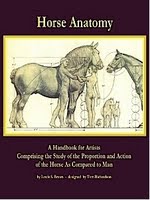
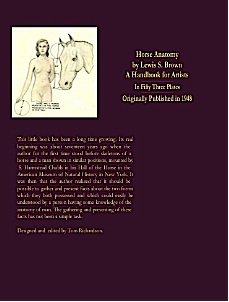
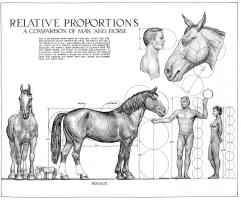
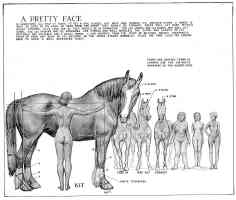
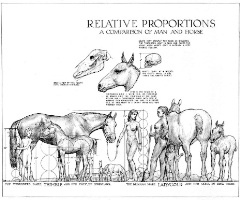
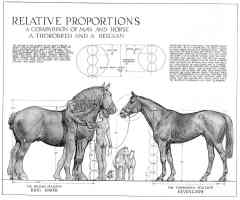
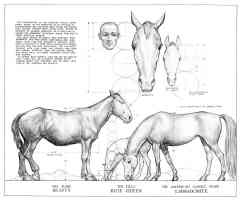
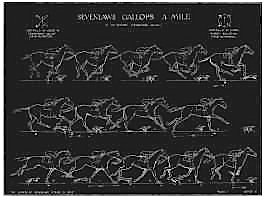
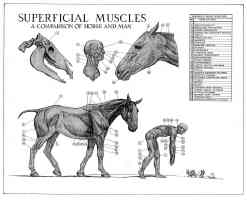
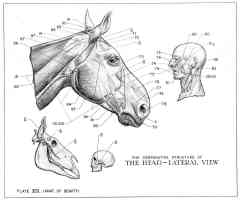
|
This amazing book was a labor of love by the author who was taken with the idea of comparing the physical structure of man to that of the horse when he saw an exhibit of skeletons of a man and a horse arranged in similar positions in the American Museum of Natural History in New York City. He worked on it as time allowed for seventeen years and eventually published it in 1948. From what I can tell that was the only edition. It includes accurate drawings of horses and men and women juxtaposed with each other with charts of human proportions compared with horse proportions, and drawings of muscular structure and skeletal structure. He also includes studies of the horse gait which were based on the work of Eadweard Muybridge's Animal Locomotion. See Horses and Other Animals in Motion: 45 Classic Photographic Sequences Lewis Stacey Brown was himself an employee of the American Museum of Natural History. He edited another book An Atlas of Animal Anatomy for Artists |
|
Table of Contents:
FOREWORD POINTS OF THE HORSE INTRODUCTION PART I PROPORTION Arabian Percheron Belgian Thoroughbred. Standardbred Saddle bred Hunter Shetland Ass PART II MOTION Animal Motion The Walk Pulling The Amble The Slow Trot The Fast Trot The Rack The Canter The Gallop The Leap PART III STRUCTURE General Anatomy The Skeleton Muscle Structure ANATOMY OF BEAUTY Outside Layer of Muscles Deeper Muscles Skeleton COMPARATIVE STRUCTURE OF POSTERIOR LIMB Back View Outside View Medial View Front View COMPARATIVE STRUCTURE OF FORE LIMB Three Quarter View Lateral View Front View Back View Medial View THE HEAD Lateral View Front View BIBLIOGRAPHY |
List of Illustrations:
Points of the Horse Poor Conformation Two Work Horses Clydesdale Mare Common Horse Horses Under Saddle Draft Type Show Type Proportions of Work Horse Proportions of Arabian Stallion Proportions of Arabian Mare Proportions of Percheron Mare Proportions of Percheron Stallion Speed and Draft Types Compared Proportions of Race Horse Proportions of Colts Proportions of American Saddle Horse Proportions of Two Hunters Proportions of Shetland Pony Proportions of Mules Proportions of Asses Bucking Horses Beauty Walks Beauty Pulls a Load Labradorite Ambles Slow Trot of Beauty Fast Trot of Abelard Fast Rack of Abelard Thimble Canters Sevenlaws Gallops Extension in Gallop Suspension in Gallop Thimble Leaps a Fence Superficial Muscles Bone Structure Superficial Muscles Outside Muscles of Beauty Deeper Muscles of Beauty Skeleton of Beauty Posterior Limb - Back View Posterior Limb - Outside View Posterior Limb - Medial View Posterior Limb - Front View Fore Limb - 3/4 Front View Fore Limb - Lateral View Fore Limb - Front View Fore Limb - Back View Fore Limb - Medial View The Head - Lateral View The Head - Front View |
|
From the Foreword: This little book has been a long time growing. Its real beginning was about seventeen years ago when the author for the first time stood before skeletons of a horse and a man shown in similar positions, mounted by S. Harmstead Chubb in his Hall of the Horse in the American Museum of Natural History in New York. It was then that the author realized that it should be possible to gather and present facts about the two forms which they both possessed and which could easily be understood by a person having some knowledge of the anatomy of man. The gathering and presenting of these facts has not been a simple task. The author wished to produce a work which would be of real use to artists. Artists learn much more from what they see than from what they read. Therefore pictures should be used rather than text whenever practical. It should be so arranged that a person with little knowledge could find a place to begin and as his knowledge grew could continue to find enough information to satisfy his needs. In other words it should be simple yet complete. Complete in the information it contained, yet simple in the way in which it was presented. It would not be a new method or short cut to drawing the horse for good drawing is only based on knowledge. The information in this volume has come from many sources. These have been studied and checked against other sources in an attempt to eliminate as many errors and fallacies as possible. In his studying the author came to realize that there existed outside of nature itself, three great sources of information on the horse of particular interest to the artist. Over sixty years ago, Eadouard Muybridge made the first careful accurate photographic studies of horses in motion. A little later Professor Ellenburgher made a very careful series of anatomical drawings still used in the best works for veterinarians. S. Harmstead Chubb of the American Museum of Natural History in New York pioneered in accurate studies of action as it related to, and is dependent upon, the skeleton. In his Hall of the Horse are his mounted animals in positions indicative of life, a great departure from the old stringing together of bones, and of unique interest and value to the man who would make an accurate drawing of the horse, as a correct expression of outward form requires a knowledge of this internal structure. The author is much indebted to the pioneer work of these men in his drawings of the bones, the muscles, and the gaits. The charts on proportion are based on actual measurements of horses and of people. It must be understood that there is some difference of opinion as regards the notable characteristics of the different breeds. The author has tried to combine the opinions of many people rather than to express only his own. It has been the author's experience that in the beginning the artist needed most to learn proportion, next, possible action, and last, to complete a drawing, the structure of muscles and bones. The sections in this book have been arranged that way, going from the general to the specific. From the Introduction: The first thing to realize about horses is their variability. The family name equidae, meaning horses, includes such varied forms as zebras, donkeys, Shetland ponies,Thoroughbreds, and Belgians. We are going to interest ourselves only in the kinds of horses an artist or illustrator might have occasion to draw. Only a few horses are pure bred. By pure bred we mean animal which comes up to the standard set by a breeding society for a special kind of horse. There are about twenty recognized breeds. Before entering upon a careful study of breeds, it is important to consider which points determine whether an animal is a good or a poor specimen. If an illustrator is called upon to draw an old gray mare he will wish to give her some of the defects found in old, poor horses. If he is to draw a racing thoroughbred, he will wish to know the points which are characteristic. The following eight pages show generalizcd bits of information. It must be understood that a horse is considered good or poor structurally only in relation to the work he is supposed to perform. The strains to which a pulling draft horse is subjected would quickly ruin a light weight, rangier animal. The peculiar shocks that a hunter's legs must take, would be unendurable to a heavy Percheron of approved type, assuming that he could, under any circumanstances, project himself into the air and over a high barrier. In addition to the adaptability of structure to a given action, there is generally a special period of training to fit the animal to its task. Structurally the thoroughbred flat racer may differ but little from a thoroughbred jumping hunter. Most of the animals shown have been given names in order to more easily identify them. These names are purely fictitious, although an attempt has been made to simulate the kind of name usually given to the breeds represented. |
|
From Model Horse Reference: Horse Structure Reference Library Listing
compiled by Sarah Minkiewicz-Breunig "HORSE ANATOMY, A Handbook for Artists, Comprising the Study of the Proportion, Structure and Action of the Horse, as Compared to Man, Lewis S. Brown, 1948, Bridgman Publishers, Inc., Pelham NY. Comments: A totally gorgeous book filled with beautiful illustrations of horses and nudes (go figure). Deals largely with proportional issues, but also with motion issues of the horse. The pages illustrating anatomy of both horse and man are fabulous. If you can find this book, absolutely get it." |
|
Original editions at Amazon.com:
Search for related books at
Abebooks.com
Horses and Other Animals in Motion: 45 Classic Photographic Sequences Muybridge's Animals in Motion CD-ROM and Book (Electronic Clip Art) |